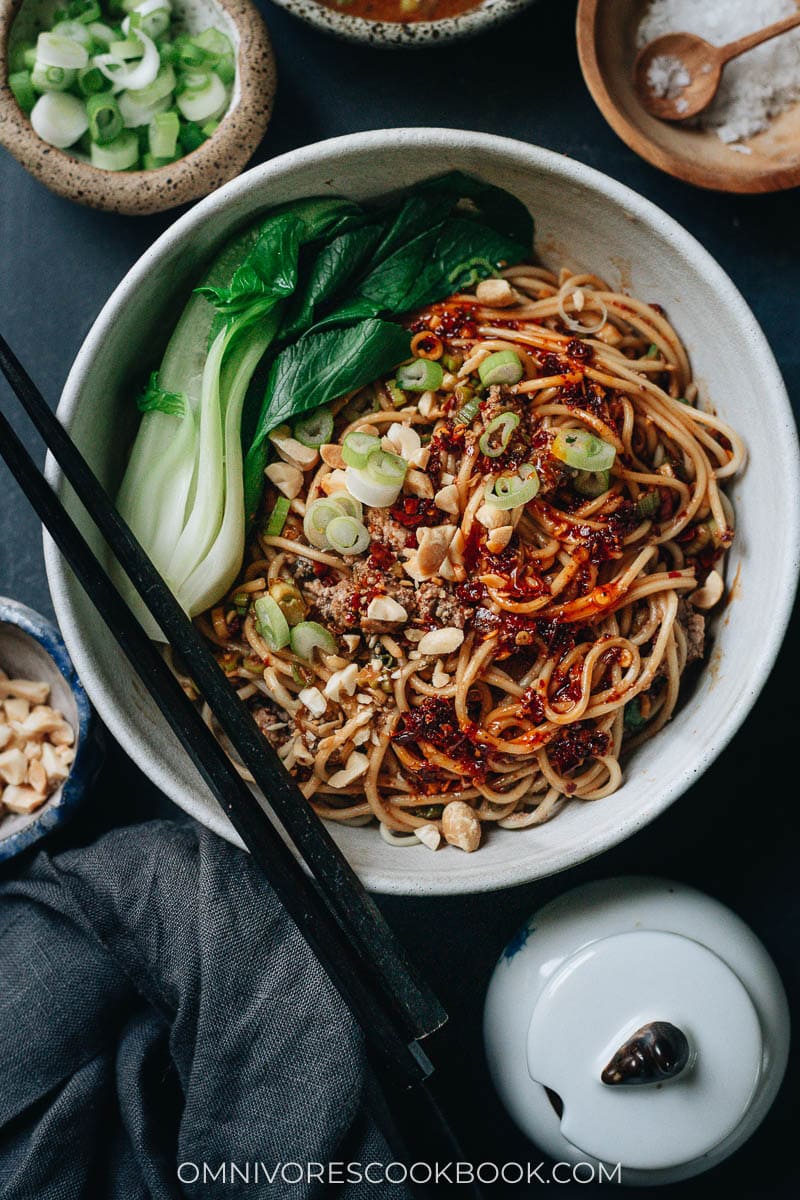
Back story
Developing a great vegan dan dan noodle recipe has been on my to-do list for a while. Over the years, I’ve had more and more readers request recipes for vegetarian and vegan Chinese food. I can see that eating healthy is not just a fad, but something that should be popular every day and will stick around.
A couple months ago, my husband Thomas started experimenting with a plant-based diet. He liked it so much that he started his own food blog Gastroplant, a recipe sharing site that documents his journey of cooking with wholesome planted-based ingredients.
Growing up eating everything, eating vegan didn’t really cross my mind (my blog literally has the word Omnivore in it!). In addition, I thought it would be too hard for me to give up fried chicken, runny eggs, and melted cheese. I thought vegan cooking had too many limitations that would affect the flavor and enjoyment.
My opinion changed after I had experimented with a vegan diet for a month.
During that time, not only did I feel better and more energetic, lose weight, and maintain my training, I enjoyed the food so much that I thought I could go 100% vegan after all. After the trial, now I eat 70% plant-based food. The morning green smoothie has become a part of my routine. I’m happy that I can now enjoy a vegan Tonkotsu ramen and chili that tastes as scrumptious as the meat version, without feeling guilty. And I can satisfy a sugar craving with these beautiful miso peanut butter cups after dinner without worrying about gaining weight.
I started to change my perspective. Instead of viewing plant-based cooking as a limitation, now I think it provides me with more tools to create great taste from wholesome ingredients.
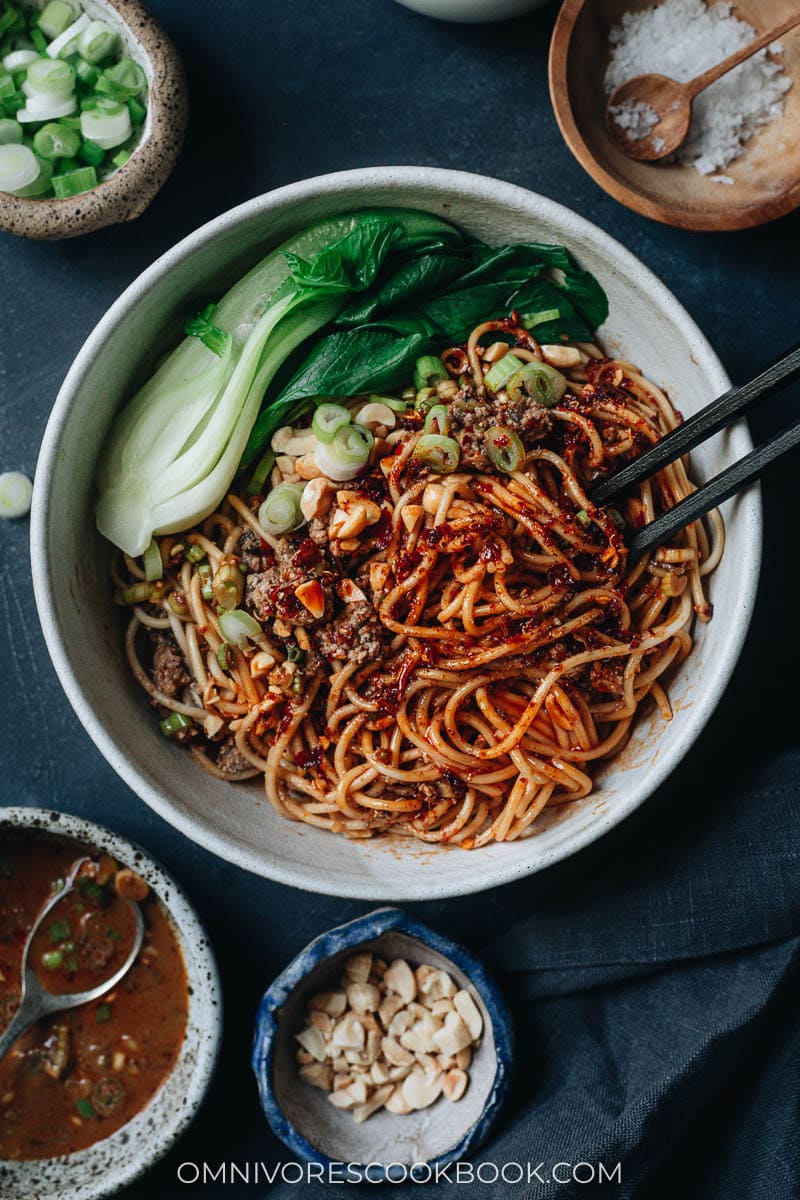
Traditional Dan Dan noodles, veganized
OK, enough story sharing and more about cooking.
I published the traditional Chinese Dan Dan Noodles recipe a while ago, but I received some readers’ requests for a vegan version. Had I not tried out the vegan diet, I would have replaced the minced pork topping with some stir-fried shiitake mushrooms and called it a day.
Last weekend when I was tasting the vegan chorizo my husband made, I got very inspired and created my version of the “meat” topping.
Vegan meat topping Ingredients
The ingredients used in the vegan meat include tofu, mushrooms, and pecans. You will
- Blend the mushrooms, pecan, green onions and garlic first to small pieces
- Very coarsely blend the tofu so it mix in, but still have some small bite-size pieces
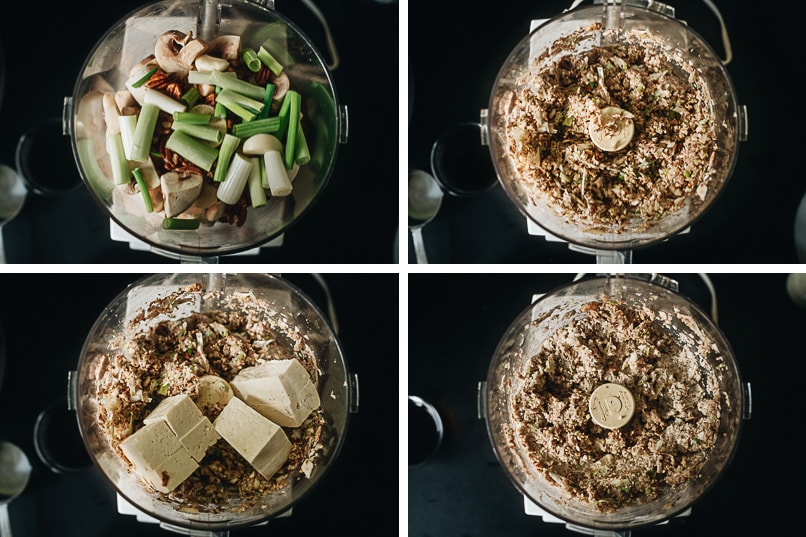
Instead of cooking the green onion and garlic separately, like in traditional Chinese recipes, I decided to blend them into the vegan meat. This shortens the prep time and the result was just as great.
Cook the vegan meat topping
To cook the topping:
- Cook the tofu mixture until it’s not watery anymore
- Add the seasonings
- Cook until it turns a bit golden brown
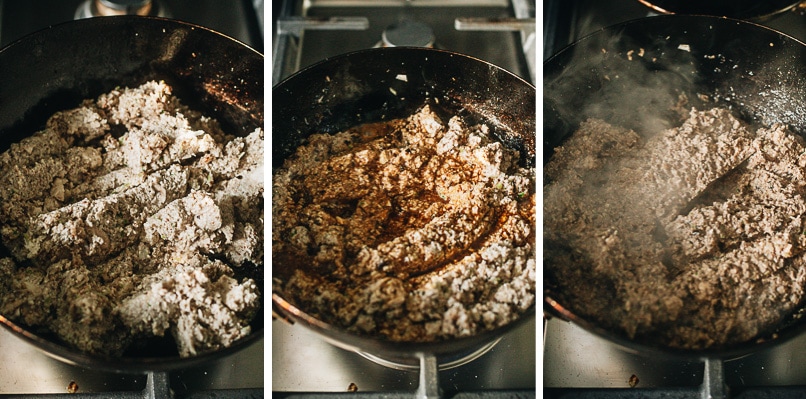
The mixture looks like a pile of mush when you add it to the pan. But once you add the seasonings and cook it down, it will eventually become a thick paste that holds its shape. When mixing the noodles with the sauce, it breaks apart nicely and mimics the texture of minced meat.
The recipe yields a bit more topping than you might need, so you can use it in a variety of ways. You can use it to top noodle soup, rice bowls, and other veggie dishes as a meat alternative.
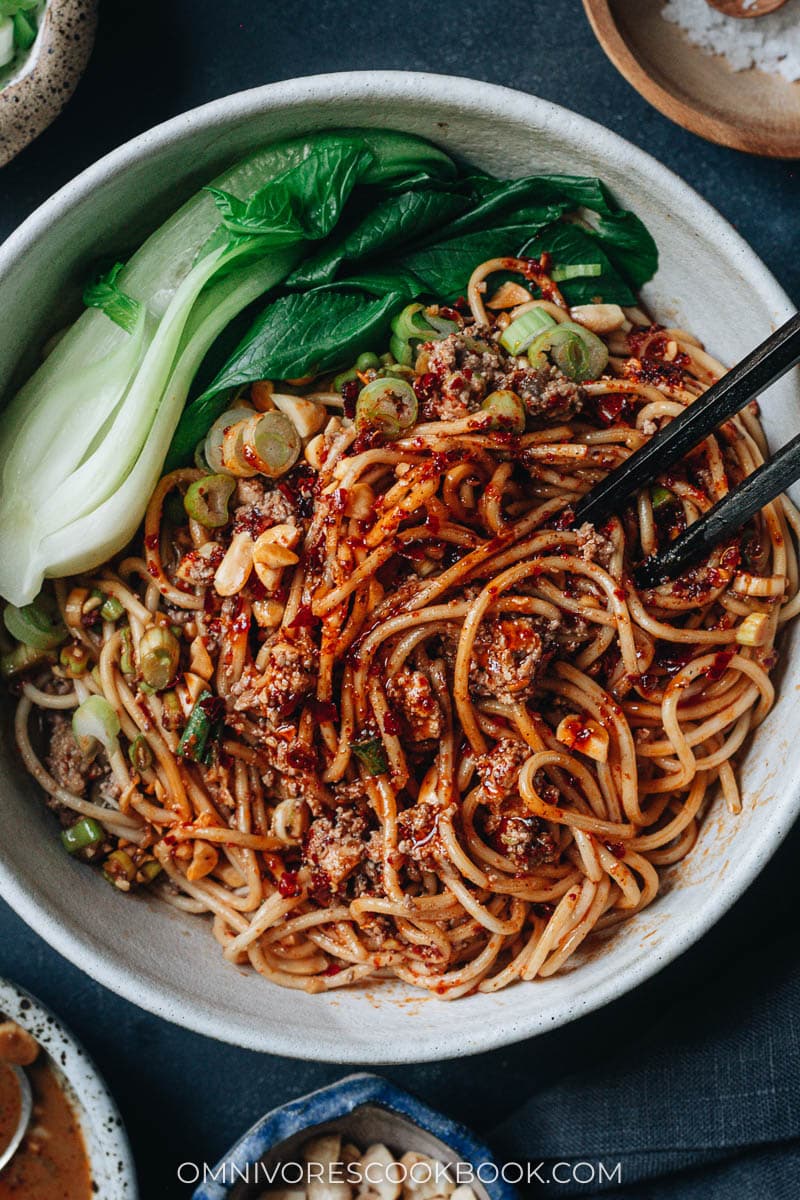
Vegan dan dan noodle ingredients
Secret ingredient – Sui Mi Ya Cai
Sui Mi Ya Cai (碎米芽菜) is a must-have ingredient if you want to call a dish dan dan noodles in China. It is not just any type of fermented mustard green, but a type of cardamine bean sprout that is native to Sichuan. It is dried, flavored with sugar and spices, and fermented. The end result is a dark brown pickle that has a crunchy texture and a one-of-a-kind taste — a bit sweet, salty, savory, with an earthy umami.
I used this ingredient to cook the vegan meat, which yields a result just like traditional dan dan noodles.
I was a bit reluctant to include this ingredient because it is not so common outside of China. Luckily, my friend Taylor carries it and you can purchase it here. I also found one vendor who carries it on Amazon.
If you don’t have this ingredient, no worries. What you can do is to add two to three rehydrated shiitake mushrooms to the vegan meat mixture. Then use 2 tablespoons of fermented black beans to replace the Sui Mi Ya Cai.
Homemade chili oil
Chili oil is a staple in every household in Sichuan and the homemade version is a must. It is the main ingredient in dan dan noodles and I highly recommend you make your own. Making chili oil might look daunting at first, but trust me, it only takes 5 minutes. Check out this post to learn how.
A quick note to anyone who prefers to avoid spicy food — you will still benefit from the homemade chili oil. When you’re making the noodle sauce, you can add a small amount of chili oil to infuse some aroma and smokiness; your dish won’t end up very spicy.
Chinese sesame paste
Chinese sesame paste (芝麻酱, zhi ma jiang) is a thick paste made from toasted sesame seeds. Although a lot of original Sichuan dan dan noodle recipes do not contain this ingredient, I prefer to use it to make the sauce creamier. It also balances the spiciness to round out the flavor. It adds great umami too, so your sauce will still taste great even if you don’t want to add too much chili oil.
You can find Chinese sesame paste in most Asian grocery stores, or purchase it online.
Please note, Chinese sesame paste tastes VERY different from tahini. Do not use tahini as an alternative. If you don’t want to purchase Chinese sesame paste, you can also use unsweetened peanut butter with a few teaspoons of sesame oil mixed in.
TIP
If this is your first time cooking with Chinese sesame paste, you may find it quite solid and very difficult to dissolve into the sauce.
The best way to mix the sauce is to add the sesame paste into a bowl first, then mix in the liquid ingredients little by little. Whisk the mixture with a spoon until the solid paste is fully blended with the liquid. Then add more liquid and repeat.
Type of noodles to use
You will need to use thin wheat noodles for vegan dan dan noodles. My favorite noodles are the Shanghai Yangchun Noodles by Havista, which is a great fresh noodle brand that you can easily find at major Asian grocery stores such as H Mart. The other thin type of noodles is “dragon whiskers (Long Xu Mian, 龙须面), which is a bit too thin for this dish.
If you cannot find this one, any type of dried thin noodles will work.
Mise en place
When you’ve done prepping and cooking, you will have: boiled noodles, blanched baby bok choy, vegan meat topping, sauce, chopped peanuts. All you need to do is assemble the bowl!
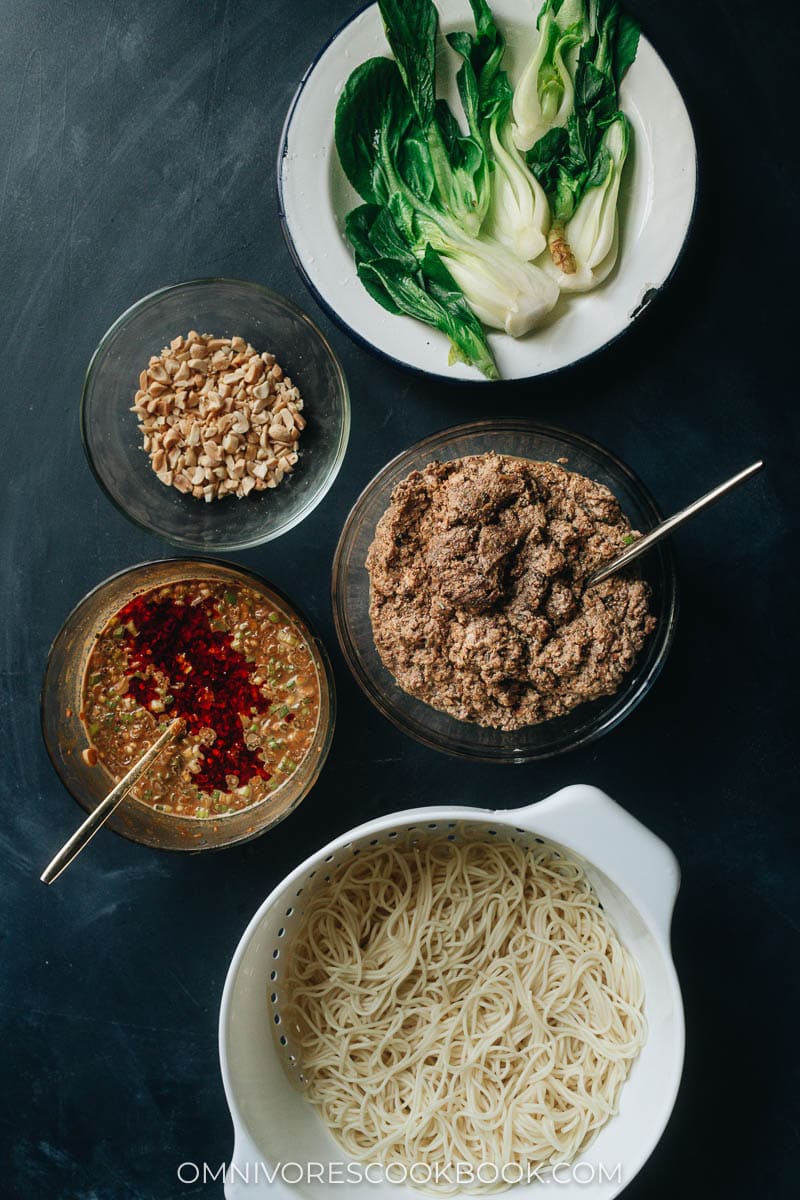
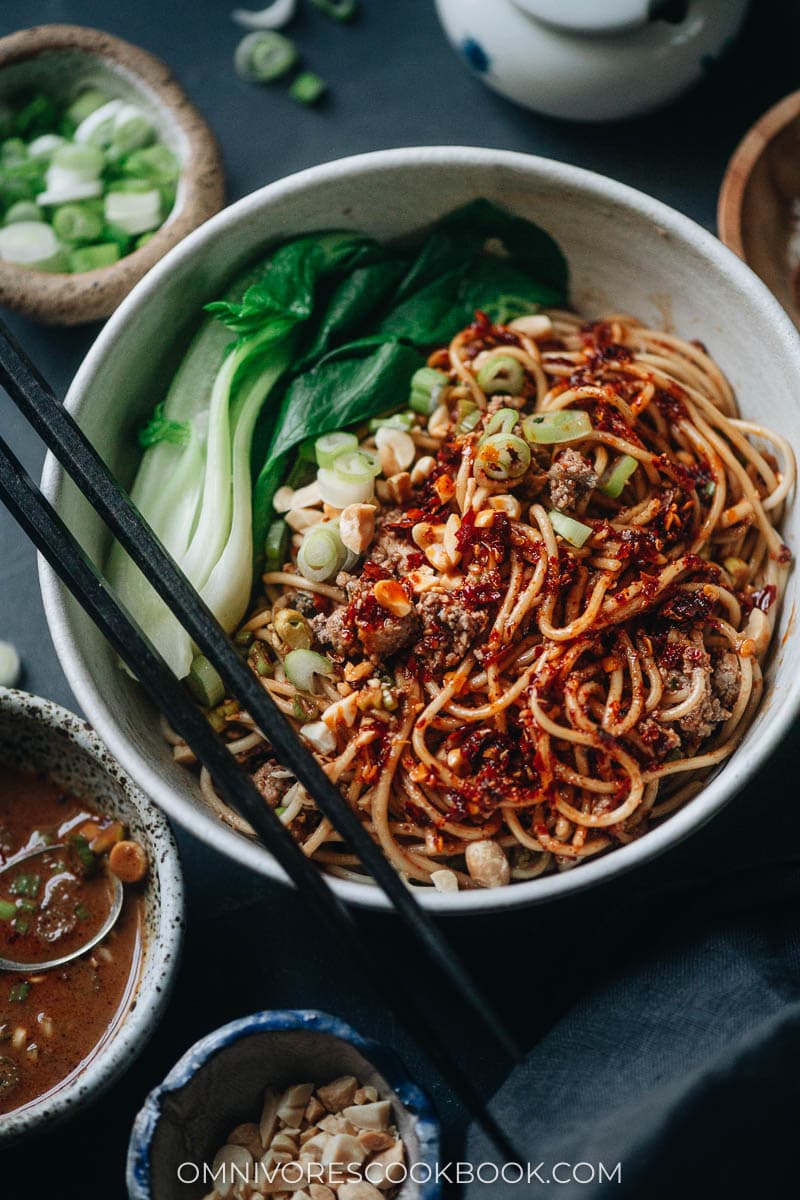
Assemble dan dan noodles
Traditionally, street vendors always add the sauce first to a bowl, then the noodles and the toppings. For home cooks, I found the order doesn’t matter too much and I use the order of:
- Adding noodles to single serving bowls
- Pour on a few spoonful of the sauce
- Add the vegan meat topping, baby bok choy and peanuts
I always serve the rest of the sauce and extra chili oil on the side, so you can always add more.
When you mix it up, the vegan meat topping will cling to the noodles and make it so delicious!

I hope you enjoy this one as much as me!
More vegan Chinese recipes
- Mapo Tofu
- Basic Chow Mein
- Vegan Oyster Sauce
- General Tso Tofu
- Hot and Sour Soup
- Eggplant with Garlic Sauce
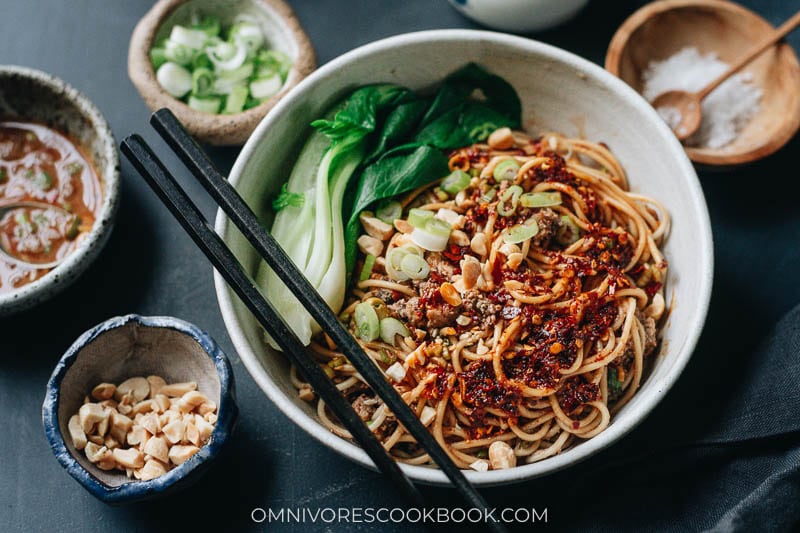
Chinese Cooking Made Easy
Are you new to this website? This free email series is a great place to start. I’ll walk you through a few of my most popular recipes and show you how and why they work. You’ll quickly start to cook better Chinese food in your own kitchen.
Watch video
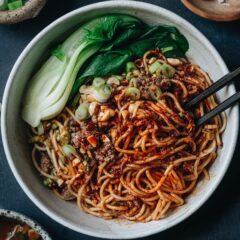
Vegan Dan Dan Noodles
Ingredients
Vegan meat topping
- 1/2 lb mushrooms
- 1/2 cup pecans (or walnuts)
- 3 green onions , coarsely chopped
- 3 cloves garlic , peeled
- 1/2 block tofu (1/2 lb / 225 g)
- 1 1/2 tablespoons soy sauce
- 1/4 cup Sui Mi Ya Cai (*Footnote 1)
- 2 tablespoons Shaoxing wine
Noodle sauce
- 4 tablespoons Chinese sesame paste (or unsweetened natural peanut butter)
- 4 tablespoons soy sauce
- 4 tablespoons Chinkiang vinegar
- 4 cloves garlic , finely minced
- 3 green onions , finely minced
- 2 tablespoons sugar
- 1/3 to 1 cup homemade chili oil with flakes (or to taste) (*Footnote 2)
- 1/2 teaspoon ground Sichuan peppercorns
To assemble
- 10 oz thin wheat noodles , dried (or 1 lb / 450 g fresh noodles)
- 4 to 6 heads baby bok choy , roughly chopped (or spinach, chard, yu choy etc.)
- 1/4 cup roasted peanuts , crushed (Optional)
- 1/2 cup roasted peanuts (Optional)
Instructions
Prepare sauce
- Whisk sesame paste and light soy sauce until fully incorporated. Add Chinkiang vinegar. Continue stirring until mixed. Then mix in garlic, green onion, and sugar.
- Add homemade chili oil, a tablespoon at a time. Mix and taste the sauce. Add more chili oil if you want more spiciness. It’s always safe to mix in a small amount now, and serve more on the side so each individual could add more to their own bowl.
- Add toasted and ground Sichuan peppercorns, 1/2 teaspoon at a time. Taste as you mix, until you can taste the numbingness but can still handle it. The more chili oil you add, the more Sichuan peppercorns you will need.
- The consistency of the sauce can vary depending on the thickness of the sesame paste (peanut butter). If the sauce is too thick, add some water and mix well.
Prepare toppings
- Combine the mushrooms, pecans, onion, and garlic in a food processor. Blend until the ingredients are chopped into small bits. Add the tofu. Pulse a few times until the tofu is coarsely chopped. You can also use your hands to break up the bigger pieces of tofu.
- Heat oil in a skillet or a wok over medium heat until hot. Add Sui Mi Ya Cai. Stir a few times to release the fragrance.
- Add the tofu mixture; cook and stir until the bottom of the pan looks dry, 1 to 2 minutes.
- Add the soy sauce and cooking wine. Use a spatula to release any bits that are stuck to the pan. Turn to medium to medium-low heat. Cook, stirring occasionally, until some part of the paste turns golden brown, 6 to 8 minutes.
- Transfer everything to a bowl and set aside.
Prepare the noodle bowl
- Bring a medium pot of water to a boil. Add the baby bok choy. Cook for 40 seconds to 1 minute, until turning tender. Remove the baby bok choys using a slotted spoon, rinse with cold tap water to stop the cooking, then thoroughly drain and set aside.
- In the same pot of water, cook noodles according to the package instructions. Drain the noodles, rinse with cold tap water to stop cooking, then drain again.
- For each noodle bowl, add the noodles, spoon some sauce onto them, add the vegan meat topping, garnish with baby bok choy, sprinkle the crushed peanuts (if using), and mix well. Serve hot or at room temperature.
Notes
- If you cannot find Sui Mi Ya Cai, you can use 2 tablespoons of black bean sauce or fermented black beans to add umami to the vegan meat. Also, you can rehydrate 2 to 3 shiitake mushrooms and add them to the meat mixture. Dried shiitake mushrooms will add an intense and hearty umami to the mixture.
Nutrition

Did you make this recipe?
I’d love to hear how it turned out for you! Please take a moment to leave a 5-star rating ⭐️ and share your thoughts in the comments further down the page. It really helps others discover the recipe too.
The post was published in Jan 21, 2019 and updated by Apr 27, 2022 with new video and images.

Tessa
The recipe says to stir in agave syrup but the ingredients don’t say anything about it. How much should I add? I’m excited to try this
Maggie Zhu
Hi Tessa, sorry for the confusion! It should be “sugar” (under the noodle sauce, 2 tablespoons), not agave syrup. I used to use agave syrup in my old recipe, but changed it into sugar because it’s a more common pantry ingredients. If you prefer to use agave syrup, you can use 2 tablespoons agave syrup to replace the sugar when making the noodle sauce.
Mike
I made this last night and I’m very impressed. The “meat” mixture alone is worth it. I foresee myself using this in a variety of dishes. I was able to find the all the unusual (for me) ingredients at our local asian market. I used store bought chili crisp, but will try your recipe next time. I didn’t have Sichuan peppercorns so I subbed green Sichuan pepper oil (1 tsp.). I’ll look for the peppercorns next time, as I felt the oil was a bit overwhelming.
Thanks for sharing the recipe. Now I have to go through your site and see what other marvels await.
Maggie Zhu
Hi Mike, I’m so happy to hear you enjoyed the dish! Green Sichuan pepper oil has a different flavor than the red type, and it’s quite potent (I like it, but it can taste quite numbing in this dish). I hope you can find the red peppercorn next time.
Thank you for leaving a positive review!